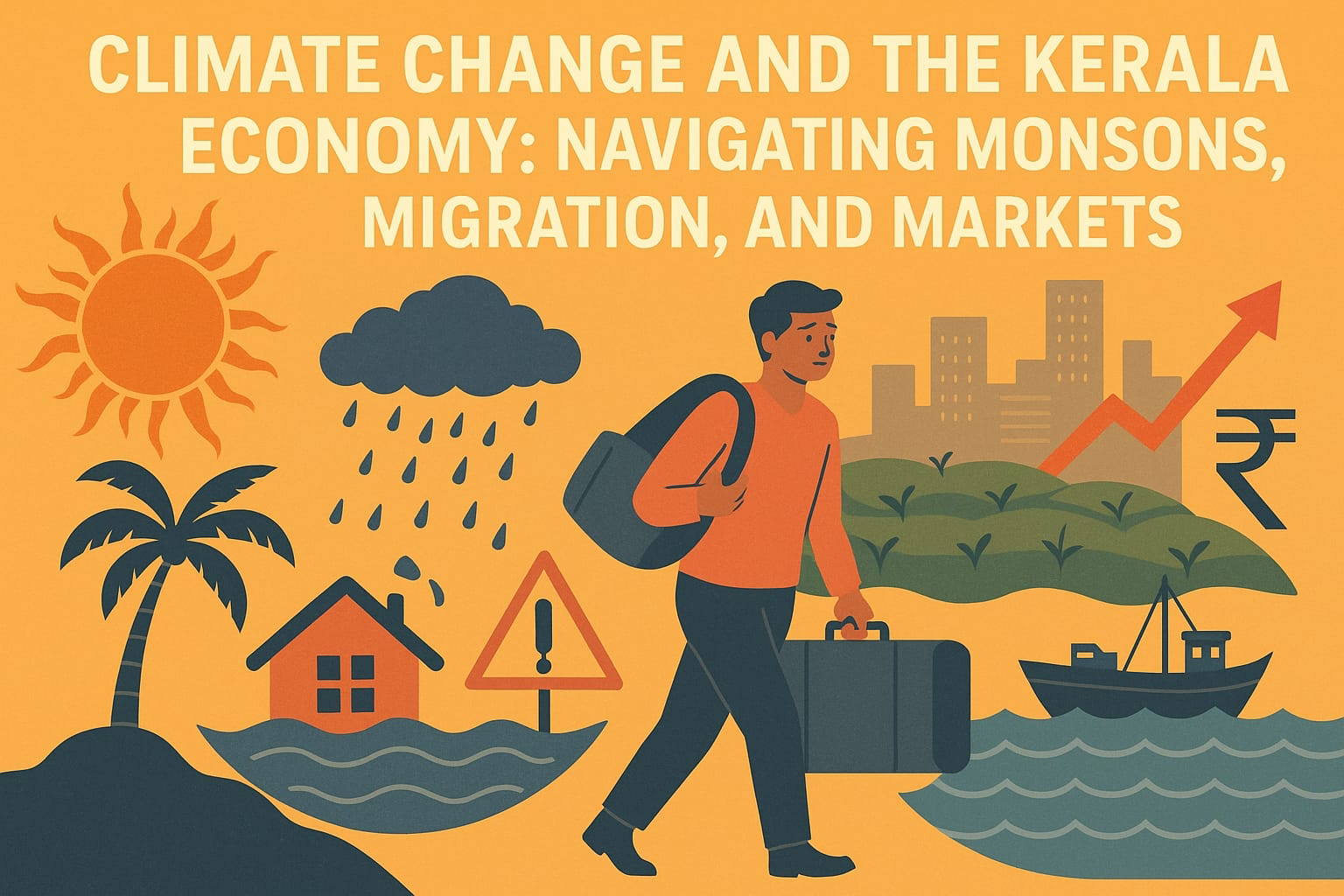Climate Change and the Kerala Economy: Navigating Monsoons, Migration, and Markets
Climate Change and the Kerala Economy: Navigating Monsoons, Migration, and Markets
---
Introduction
Kerala, often referred to as "God's Own Country," has long enjoyed a unique economic and ecological landscape. However, the state now finds itself on the frontline of climate change. From erratic monsoon patterns to frequent floods, rising sea levels to declining agricultural productivity, the impacts of climate change are no longer distant or theoretical—they are urgent and unfolding. This article delves into how climate change is influencing the Kerala economy across various sectors, the demographic shifts it causes, and the potential avenues to mitigate and adapt through policy, technology, and community resilience.
---
1. Climate Change and Agriculture: A Sector in Peril
Agriculture in Kerala, though contributing only around 10% to the state's Gross State Value Added (GSVA), is central to the livelihoods of millions. Climate change, however, is undermining its viability:
Shifting monsoons: Traditional patterns have been disrupted. The southwest monsoon, crucial for paddy and plantation crops, is increasingly erratic.
Crop failure and diseases: Increased humidity and fluctuating rainfall lead to crop diseases, such as rot in black pepper vines and fungal infections in rubber.
Irrigation and water stress: With unseasonal rains and long dry spells, the demand for irrigation increases even in previously rain-fed zones.
The economic loss from the 2018 and 2019 floods alone was estimated at over Rs. 30,000 crore, with agriculture accounting for a large share. Farmers are increasingly shifting to low-risk, low-return crops or abandoning agriculture altogether.
---
2. Fisheries and Coastal Livelihoods: On the Frontline of Sea-Level Rise
Kerala’s 590-kilometer coastline supports over 10 lakh people engaged in marine fishing and related activities. Yet this coast is one of the most vulnerable to sea-level rise and coastal erosion.
Erosion and salinization: Coastal erosion has displaced thousands, while saltwater intrusion affects inland water sources and agriculture.
Decline in fish catch: Rising sea temperatures and changes in ocean currents affect fish breeding cycles and migration patterns.
Occupational vulnerability: Many traditional fishermen are migrating to cities or shifting to alternative work, increasing pressure on urban economies.
The cumulative effect is not just economic loss but cultural erosion—entire communities are losing traditional livelihoods passed down generations.
---
3. Tourism: A Climate-Sensitive Industry
Kerala's tourism, especially ecotourism and monsoon tourism, is deeply tied to the state's climate and natural beauty. Climate change disrupts both.
Frequent floods and landslides: These deter tourists, especially during monsoon months.
Degradation of attractions: Backwaters, beaches, and hill stations suffer from environmental degradation, reducing their appeal.
Infrastructure strain: Roads, bridges, and hospitality infrastructure are frequently damaged due to extreme weather events.
Tourism contributes nearly 10% to Kerala's economy. Its vulnerability threatens not just direct employment in hotels and travel, but also allied sectors like handicrafts, food production, and transport.
---
4. Public Health and Economic Productivity
Rising temperatures and flooding increase the prevalence of diseases like dengue, chikungunya, and leptospirosis, leading to higher healthcare costs and reduced labor productivity.
Heat stress and outdoor labor: Workers in agriculture, construction, and manual sectors are particularly vulnerable.
Increased disease burden: The state’s health expenditure is rising, putting pressure on public finances.
The health implications of climate change affect economic output both directly (sick days, hospital costs) and indirectly (education dropouts, increased caregiving burdens).
---
5. Migration: Climate-Induced Displacement and Urban Pressure
Kerala already has a complex migration profile—both as a sender of international migrants and a receiver of domestic migrants. Climate change adds a new dimension:
Internal displacement: Floods and coastal erosion have displaced thousands.
Urban congestion: Cities like Kochi and Trivandrum face infrastructural and housing stress as climate refugees move in.
Remittance vulnerability: Global climate policies may affect job security in Gulf countries, reducing remittances that form a backbone of Kerala’s economy.
Migration is not just a humanitarian concern but a structural economic issue. Planning and housing need to integrate these emerging patterns.
---
6. State Finances and Disaster Costs
Kerala's debt burden is among the highest in India. Climate disasters add to this strain:
Disaster relief and rehabilitation: Large-scale relief expenditures cut into development spending.
Insurance shortfalls: Limited penetration of crop and health insurance leaves households vulnerable and increases demand for public support.
Infrastructure rebuilding: Roads, public buildings, and utilities need repeated repair.
The fiscal stress risks creating a vicious cycle—less investment in resilience due to lack of funds, leading to greater damage and even higher recovery costs.
---
7. Opportunities: The Green Economy in Kerala
While climate change poses serious threats, it also opens pathways for innovation and sustainable development:
Solar energy: With over 300 sunny days annually, Kerala can scale up rooftop solar and off-grid solar systems.
Eco-tourism and green certification: New-age travelers seek sustainability. Promoting carbon-neutral destinations can attract responsible tourism.
Agroecology and climate-resilient farming: Indigenous farming methods and crop diversification can help build climate resilience.
Carbon markets and credits: Kerala can monetize its forest cover and green practices through voluntary carbon markets.
Investments in the green economy not only create jobs but also align Kerala’s development with climate goals.
---
8. Policy Responses and Governance Challenges
Kerala has been proactive in responding to climate risks, but challenges remain:
Draft Climate Resilience Strategy: The state has proposed a multi-sectoral adaptation framework.
Local self-governments (LSGs): Grama Panchayats are increasingly involved in flood planning and ecosystem restoration.
Knowledge and data gaps: Real-time data on rainfall, soil, and tides is lacking in many districts.
Coordination challenges: Fragmented responsibilities among departments slow down implementation.
Stronger inter-departmental coordination, participatory governance, and investment in scientific monitoring are critical.
---
9. Community Resilience and Civil Society Response
Kerala's vibrant civil society plays a crucial role in climate response:
Fisher cooperatives and women’s groups are active in awareness campaigns.
Post-flood volunteering showed how community mobilization reduces disaster response time.
Students and youth are increasingly involved in climate advocacy.
Building resilience from the ground up is often more sustainable than top-down models.
---
10. Kerala’s Climate Future: A Policy Roadmap
For Kerala to transform climate risks into opportunities, a comprehensive policy roadmap is essential:
Integrated River Basin Management: To manage floods, droughts, and drinking water systems holistically.
Urban Climate Resilience Plans: To prepare cities for in-migration, heatwaves, and infrastructure stress.
Climate Budgeting: Tagging of government expenditures related to adaptation and mitigation.
Skill training for green jobs: From electric vehicle repair to solar panel installation.
Investment in Research: Linking universities with policy for evidence-based decision-making.
---
Conclusion
Kerala’s economic future is inextricably linked with its climate resilience. The challenges are real and growing—but so is the potential for innovation, community engagement, and sustainable growth. The question is no longer whether Kerala can afford to act on climate change. The question is whether it can afford not to.




Comments
Post a Comment